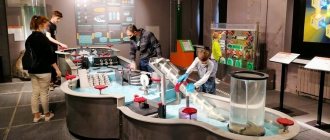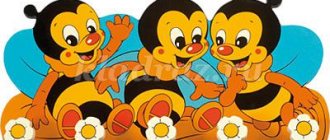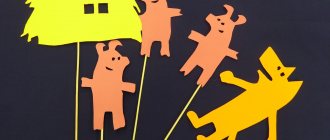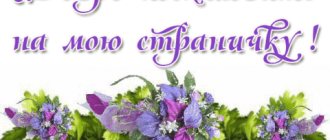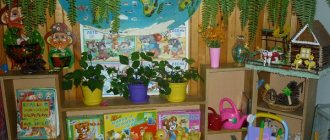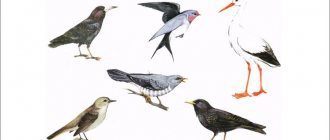Attention! The article provides an example of a portfolio.
A preschooler’s portfolio is a folder in which the child’s talents, successes, and preferences are “collected.” Portfolios are increasingly required in preschool institutions. Children who do not attend preschool educational institutions, one way or another, become the heroes of the portfolio - in the popular series of photo albums “I was born, I am growing.”
Why do you need a preschooler's portfolio?
Parents have an ambivalent attitude towards portfolios. On the one hand, many consider this an unjustified waste of time and a useless undertaking: they say, if a preschooler has a bad portfolio, will he be expelled from the kindergarten or not accepted into school? Opponents of the portfolio argue their point of view by saying that a kindergarten should be involved in raising a child, regardless of his status, welfare or epistolary skills of the parents, but here it turns out to be some kind of paperwork.
Another camp encourages children to have portfolios. Parents understand the importance of drawing up a reference folder. Portfolios are often required to help teachers. Having learned from the portfolio what games the child likes to play, what toys he likes, what assignments he is most willing to carry out, the teacher will be able to correctly and competently build a line of behavior with the preschooler and help him quickly adapt to the team.
Having received from the teacher as homework to prepare a portfolio of a preschooler, you will have to remember and put together the main points associated with the child’s life: his preferences, hobbies, first creative works, photographs. In kindergarten, the portfolio will be supplemented with the most successful drawings and crafts, and at the graduation party you will receive back a folder with the child’s achievements.
The portfolio can be kept at home as memories of the glorious pre-school period. The portfolio may be asked to be brought to the primary school. Based on the data contained in the folder, teachers will form their own idea of the child and decide who is best to sit him with, what objects should be paid attention to - that is, by the time the baby arrives, the psychological basis for teaching in the classroom will be ready.
For teachers and parents
Often mothers and fathers (and often teachers) who are carried away by working on a portfolio for kindergarten forget that, first of all, this list of achievements is the property of the child, even if he is not yet able to print templates on his own or draw pictures for decoration. The colorful folder will become his favorite book, the key to motivation for study, creativity, and sports. There are several immutable rules regarding children's portfolios:
- Viewing the folder is possible only with the knowledge of the child himself, especially if curiosity is shown by strangers;
- Parents' help in creating a portfolio for kindergarten is mandatory, otherwise the picture of personality will be incomplete - in children, many character traits, hobbies, and desires manifest themselves exclusively in the home environment;
- All results and records are dated to track the dynamics of development. If a preschooler does not want to post a record of some event in his portfolio, do not argue with him;
- A portfolio should not be a reason for high self-esteem (or low self-esteem if the child is jealous of other people's achievements). It is important to explain to children the principles of objective assessment of their successes and capabilities;
- You cannot use children's portfolios to compare them with each other. This technique entails severe psychological trauma.
Compliance with these principles will make the process of creating a portfolio for kindergarten a bright and enjoyable episode in the child’s life. Considering his opinion today before you print out the templates and pictures for the first progress report, you are working to build trust, understanding, love in your family.
0 likes
What is included in a preschooler's portfolio
The portfolio reflects the child’s main indicators:
- physical (height, weight, etc.),
- skills (range of child's skills),
- life (travel, hobbies, etc.).
There are a lot of portfolio options, but they all differ slightly from each other. As a rule, in the garden they say which sections must be present in the folder. Some pages may be assigned to sections as desired.
Stores sell ready-made templates that contain accompanying pictures and section names.
However, more and more parents prefer to prepare a portfolio themselves. Crafty moms manage to incorporate elements of scrapbooking and Photoshop skills and turn the folder into a real masterpiece.
Required pages in the portfolio:
- General details of the child (full name, date of birth, city).
- Contents of the portfolio (this sheet lists the sections of the portfolio).
- Meet me (baby biography).
- I'm growing (height and weight chart).
- Photo from kindergarten.
- My family (a separate page can be dedicated to each family member, or you can simply post a conditional family tree).
- That's what I love (child's hobby).
- How can I help (list of tasks that can be entrusted to a child).
- My favorite books (listing of favorite authors and works).
- My travels (photos from travel).
- I dream (the child’s statements about his future profession, home, studies are recorded).
- Gold pens (photo of crafts).
- My friends.
Additional pages can be seasonal: for example, talk about how the child spent the winter, etc.; or include certificates received at various competitions.
The portfolio can be interestingly designed in the form of a multi-colored book, in which the child’s favorite cartoon characters are depicted against the background of the pages, for example.
How to design a cover?
The title page or cover, as a rule, contains a brief summary of information about the owner of the folder (last name, first name, patronymic, photograph, date and city of birth, etc.). A colorful and beautifully designed title page will attract the child's attention, encouraging him to constantly add something to the folder and revise his work.
Since the child is still small, he lives in a world of fantasy and play. Therefore, when designing the title page, you need to remember your child’s most favorite fairy-tale and cartoon characters , and it is best to involve him in this work. The main thing is not to rush, and then the creative process will bring pleasure to both adults and children.
Be sure to put a photo of a little preschooler on the cover - let him choose the one he likes.
The author L. Orlova suggests, in addition to the name, surname and date of birth, to make on the cover an image of the baby’s palm at the moment when the portfolio has just begun, and another one - at the time of completion.
The theme of the cover design for boys and girls will, of course, be different.
Design principles
A children's portfolio should not be too formal; you need to put a piece of your soul into it. When compiling, try to take into account the wishes of the owner himself in the choice of drawings, crafts and photographs. Don't forget that this is part of his life.
Colorful magazine clippings, stickers, dried flowers and leaves are suitable for decorating the pages.
You can also draw a corresponding picture with your child on each sheet, suitable for a specific topic. It is advisable to make a beautiful and interesting signature under each photo, perhaps even in verse or in a comic form.
Observe the following principles:
- work on the creation of this document should be carried out systematically;
- the preschooler must take personal part in the design of the folder and the selection of materials for it;
- creating a portfolio is voluntary - only a parent can decide whether their family needs this document or not;
- There are no strict requirements for the design of the work, the main thing is that the child likes it;
- The document should emphasize the uniqueness of the child - in this regard, it is important to prevent “competition” between parents/children - who is better!
Section two: “Favorite activities and games”
The kindergarten portfolio is ready, filled out, and in the second section it describes the child’s activities and games:
- Classes with mother, grandmother or in kindergarten, club, etc.
- A story about your favorite games in the garden and at home (cubes, children's dominoes, mosaics, etc.).
- Favorite classes based on the Zaitsev, Nikitin, Montessori, Doman systems (example of several classes).
- Favorite books (list of titles and authors).
- Favorite activities (list, for example, dancing, drawing, reading, etc.).
- Walks (games and outdoor activities).
Portfolio for kindergarten teachers
Why does a teacher need a portfolio? Its purpose is to increase self-esteem and stimulate the professional growth of teachers in children's educational institutions. As well as assessing the qualification level and quality of activity as a professional (for certification, determining the amount of incentive and incentive payments).
The structure of a kindergarten teacher’s portfolio includes sections:
- “Introduction”, where the teacher provides information about professional status, education, work experience, and personal information. (To generate this information, the teacher asks for help from the head of the preschool educational institution.)
- “Portrait” consists of the essay “Me and My Profession.” In it, the teacher freely reflects aspects: why he chose the profession, talks about the qualities that are needed for successful activities, describes the stages of formation in the profession, personal and professional interests, prospects and achievements, sets out the credo of pedagogy, analyzes professional competence, and identifies topics of innovative activity , reflects creative achievements.
- “Folder of achievements in the profession” - this section of the portfolio for kindergarten teachers contains information about the following materials: plans, reports, publications, contains a description of work experience, a list of developed manuals, videos of various forms of work with students, colleagues, parents, reviews from parents, etc. .
- The “Folder of Pupils’ Achievements” is also included in the kindergarten teacher’s portfolio. It contains certificates of children’s participation in various events, diagnostic data, and children’s creative products. The materials in this section indicate the professional competence of the teacher.
- The completed portfolio of a kindergarten teacher includes a “Document Folder” section. It contains certificates of participation in creative and professional competitions, contains documents on completion of advanced training courses, additional professional education, etc. The materials in this section indicate the official status of the teacher.
- "Folder of expert assessments." It contains letters of gratitude, patents, reviews, testimonials, etc. These documents are forms of evaluation of the teacher’s activities and stimulate his further growth.
Sample filling
Let's take a closer look at the main part, and give a sample of filling out a portfolio for a boy in kindergarten for some items. For a girl, you can fill in the same way.
There are many items, but it is not necessary that all of them should be included in the preschool portfolio. If the teacher does not specify a specific structure, choose the points you like most, taking into account, of course, that the first two should be present in any case.
"Let's get acquainted"
This section is devoted to a more detailed presentation of information about the owner than on the title page. You can indicate your place of birth, residential address, zodiac sign, include a decoding of the name and a story from your parents about why they chose this particular name.
For example, about the baby's name you can write the following:
A person is given a name at birth and it influences his entire life. That is why my mom and dad took a long time to choose my name. My grandmother wanted me to be named Alexei in honor of my grandfather, but my mother and father deliberated for a long time and finally decided that they would call me the Russian Orthodox name Yegor.
Meaning of the name
The name Egor is the Russian version of the name Georgiy, which has Greek roots and is translated as “farmer.”
Shortened versions: Egorka, Gora, Zhora, Egosha, Gosha, Goga
Since childhood, Egor has stood out for his practicality and efficiency. He is also very active and emotional. Hard work, dedication and diligence are the main traits of his character. In addition, it should be noted his heightened sense of justice. Because of this trait, Yegor can even be considered a fighter, because it is difficult for him to tolerate when someone in his environment openly lies or offends a weaker person.
In the old days, only those people who earned the trust of the king were allowed to have a patronymic name. And in our time, everyone has it and is given by the name of the father. My patronymic is Gennadievich.
For a long time, ordinary people were also not entitled to a surname. Only people with a high position in society were awarded it. Now, as in ancient times, a person’s surname is an inherited family name. My last name is Ivanov.
"The World I Live In"
This section should include information about the preschooler’s environment, his family, friends, relatives and loved ones; family tree; pictures and photographs of friends; family photo album; stories written from his words.
It would be appropriate to describe the baby’s hometown, add a photograph or drawing of a favorite park or any other place where the baby likes to walk. Be sure to tell a little about the family, add a family photo to this section, under which indicate the names of mom and dad, brothers and sisters, grandparents, and also briefly describe each family member.
In the same way, you can design a subsection dedicated to the friends of your daughter or son.
You can provide any other information that the parents deem necessary. It is imperative to consult with your child and take his opinion into account when filling out each section.
The following can be written about the family:
My mother's name is Olga Anatolyevna. She is a pediatrician, works in clinic No. 2, treats children. It’s good that my mother is a doctor - when I’m sick, she treats me herself. She also cooks delicious food and plays different games with me.
My dad's name is Gennady Pavlovich. He is a high-altitude installer. Builds big houses. I like to go fishing and ride bicycles with my dad.
My grandmother's name is Anna Ivanovna. She is retired and enjoys doing all kinds of crafts. Every summer she and I go to the forest to pick mushrooms and berries.
You can write the following about friends:
I have a lot of friends.
This is Dasha. She is my neighbor, we visit each other very often.
This is Timofey. We have been friends since childhood. He comes to his grandmother, and she lives next door.
This is Sasha. I became friends with him in the karate section.
This is Kirill. My best friend in the group. We always play together.
This is Ksyusha. My best friend in the group. I really like her.
“I’m already quite big”
Anthropometric data of different ages; contours of the palm and foot.
"My achievements"
Individual development card; the child’s successes in various fields, awards, diplomas, certificates.
In this section you can indicate clubs, additional classes, sections that the child attends. You can pay attention to the connection between these hobbies and the child’s desired future profession.
For this point you can write, for example:
I have been going to the karate section for a whole year now, and very soon I will have my first exam.
I recently participated in a children's drawing competition and took 2nd place.
My dad is teaching me to play checkers, and I’m already pretty good at it.
"My talents"
Special inclinations and abilities of a preschooler.
You can, for example, attach photographs from participation in costume performances and matinees.
You can write, for example:
I have a good memory, I quickly memorize poems, and I can recite them loudly and expressively.
I love to draw and next year I plan to go to art school.
I can also read and count, but not very well yet.
"Teachers around"
Description of the work of a teacher, psychologist and speech therapist with a kindergartener; psychological portrait of a pupil from the point of view of preschool employees; description of interaction between family and specialists; parents' recommendations.
“Seven “I”s and kindergarten”
The work carried out with the family is presented; family information; joint activities; meetings in the parents' club; reviews of joint walks and excursions; consultations for parents; reviews and job offers.
"My art"
Drawings; photographs of crafts, applications, origami, etc.
The most successful and beautiful creative works are placed here, for example, appliqué and drawings of a child with a signed date and age. The first drawing with watercolors, a leaf cut out with scissors, a pencil sketch - all this will be appropriate in this section. To prevent them from deteriorating or becoming wrinkled, it is best to place them in special files.
"Learning to read"
A list of favorite books and drawings based on the works read.
"The world around us"
Information about visiting a theater, excursion, museum, city or kindergarten festival.
You can write, for example:
On May 9, my dad and I went to the square. There I saw a lot of military equipment - I really liked it.
And recently, my mother and I were at the circus. I especially liked the numbers with the monkey and the tigers.
"Fantasy world"
Games, stories, words, drawings and creative works invented by the child.
"My kindergarten"
Information about the teachers and the group.
"Soon to school"
Photo or drawing of the school; drawings on this topic; letters and numbers that a preschooler knows; recommendations for parents; school readiness criteria.
"Who to be?"
What profession does the child dream of, what type of professional activity does he have aptitude for.
For example, you can write like this:
When I grow up, I will become an electric train driver, like my uncle. Although just recently I wanted to be a builder and build houses like dad. Perhaps I'll change my mind again.
"Suggestions and feedback"
It is extremely important for children to appreciate their efforts and work. In this section, parents or preschool employees leave feedback on the work done by the child, and educators can give recommendations from a pedagogical point of view.
As a result of drawing up a portfolio for preschool children, their individual characteristics should be revealed to the maximum, the prerequisites for successful development should be created, and conditions should be created for effective interaction with the family.
Use templates to reduce the time it takes to create such a lengthy document.
The main function of a portfolio for a kindergarten is to preserve all the most positive moments of a child’s life , increase his self-esteem, and direct him on the path to developing his skills and broadening his horizons. By taking part in the creation of this unique document, the preschooler learns to create his own image, evaluate his achievements over time and not get hung up on failures and mistakes. And it is important for parents to preserve the memory of this happy period of formation of the personality of their beloved child. After all, it will never happen again, and once you open this folder, you can always plunge into it again.
Portfolio in pictures
Section one: “My world”
Any information that is important and interesting for the child is placed here.
- Name. It tells about the meaning of the name, why it was decided by the parents to call it that way, you can also explain the surname if it is rare, this may also include the meaning of the character according to the horoscope.
- Baptismal name. Often given a middle name that corresponds to one's religion if one has been baptized.
- Family. Here the child talks about the names of his family members or draws a family tree.
- Friends. Photos of friends are posted and information about them is provided.
- Place of residence. Information about your hometown is given; photographs and descriptions can tell you about its interesting places.
- Kindergarten. Information about the kindergarten and group.



